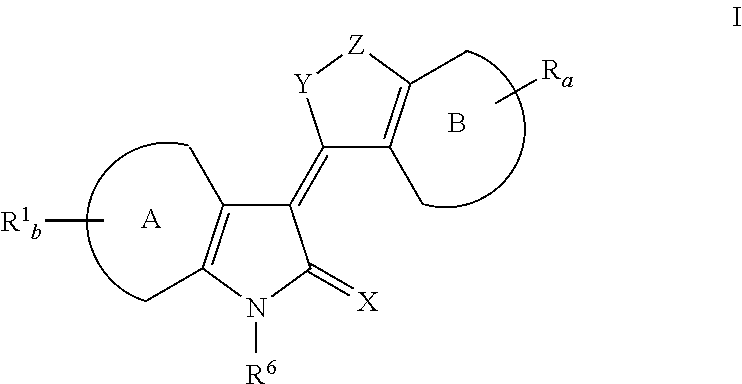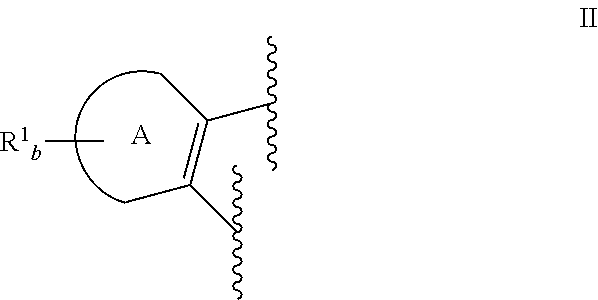Heteroaryl Dihydroindolones as Kinase Inhibitors
a technology of heteroaryl dihydroindolones and kinase inhibitors, which is applied in the field of heteroaryl dihydroindolones as kinase inhibitors, can solve problems such as malignant tumor growth, uncontrolled cell proliferation, or defects in key developmental processes, and achieve the effect of modulating, regulating and/or inhibiting tyrosine kinase signal transduction
- Summary
- Abstract
- Description
- Claims
- Application Information
AI Technical Summary
Benefits of technology
Problems solved by technology
Method used
Image
Examples
preparation 1
[0068]
7H-Furo[3,4-b]pyridin-5-one
[0069]A solution of furo[3,4-b]pyridine-5,7-dione (3.0 g, 20 mmol) in THF (20 mL) is treated with sodium borohydride (0.75 g, 20 mmol). The reaction mixture is placed under an argon atmosphere and the temperature is maintained at 15° C. with a water bath. Acetic acid (2.4 g, 39 mmol) is added dropwise at 15° C. The reaction mixture is stirred for 4 h and is then concentrated on a rotary evaporator. The crude residue is then treated with acetic acid (8 mL) and acetic anhydride (8.0 mL) and heated at 100° C. overnight. The reaction mixture is cooled and concentrated. The residue is purified by chromatography (silica gel, gradient elution 30% EtOAc / hexane to 50% EtOAc / hexane). The product containing fractions are concentrated to give the title compound as a white solid (360 mg, 27%).
example 1
[0070]
5-Fluoro-3-(7H-furo[3,4-b]pyridin-5-ylidene)-1,3-dihydro-indol-2-one
[0071]A solution of 5-fluoro-1,3-dihydro-indol-2-one (453 mg, 3.0 mmol.) in THF (3 mL) is placed under an Argon atmosphere and cooled in an ice bath. A solution of lithium bis(trimethylsilyl)amide (6.0 mL of a 1M in THF, 6.0 mmol, 3 eq.) is added slowly at 0° C. and the resulting solution is stirred for 10 min. The ice-bath is removed and a solution of 7H-furo[3,4-b]pyridin-5-one (270 mg, 2.0 mmol) in THF (6 mL) is added dropwise to the reaction mixture. The resulting solution is stirred at room temperature for 4 h and poured into a 10% aqueous HCl solution (50 mL). After 10 min at room temperature, the reaction is heated to ˜90° C. for 45 min. and then let stir at room temperature for 36 h. The solid which forms is collected by filtration and washed sequentially with MeOH, EtOAc, Et2O (3×5 mL) and dried under vacuum to give the title compound (200 mg, 37%).
preparation 2
[0072]
2-Methyl-furo[3,4-b]pyridine-5,7-dione
[0073]A solution of 6-methyl-1,2-pyridine dicarboxylic acid (25 g, 138 mmol) and acetic acid (42 mL, 733 mmol) in DME (150 mL) is treated with pyridine (22 mL, 272 mmol) and stirred at room temperature for 2 h. The pale yellow solution is diluted with ether (250 mL) and then hexane (1250 mL) is added slowly. A white precipitate is formed. The solution is cooled to 0° C. for 30 min and the white solid is collected by filtration. The solid is washed with hexane and dried to give the title compound as a white solid (16.7 g, 74%).
PUM
| Property | Measurement | Unit |
|---|---|---|
| temperature | aaaaa | aaaaa |
| temperature | aaaaa | aaaaa |
| temperature | aaaaa | aaaaa |
Abstract
Description
Claims
Application Information
 Login to View More
Login to View More - R&D
- Intellectual Property
- Life Sciences
- Materials
- Tech Scout
- Unparalleled Data Quality
- Higher Quality Content
- 60% Fewer Hallucinations
Browse by: Latest US Patents, China's latest patents, Technical Efficacy Thesaurus, Application Domain, Technology Topic, Popular Technical Reports.
© 2025 PatSnap. All rights reserved.Legal|Privacy policy|Modern Slavery Act Transparency Statement|Sitemap|About US| Contact US: help@patsnap.com



